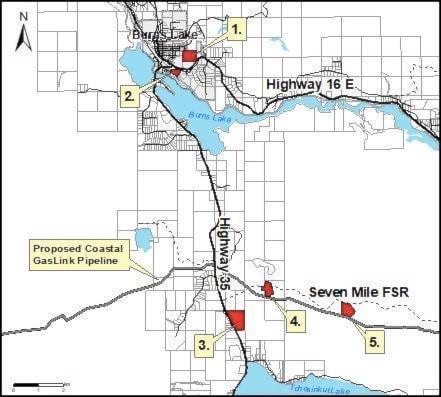A decision on the new location for a workforce camp near Burns Lake is “pending very soon,” according to Kiel Giddens, a spokesperson for Costal GasLink.
Earlier this year the pipeline proponent abandoned its plans to build a camp at a proposed site near the shores of Tchesinkut Lake after public feedback revealed overwhelming opposition. Topping the list of concerns was the potential for water pollution and drainage issues, as well as increased traffic on Hwy. 35 between Burns Lake and Tchesinkut Lake.
“Coastal GasLink is still working through its decision process in consultation with the camp contractor, First Nations, and local governments,” said Giddens, adding that the wildfire situation in Burns Lake has caused meetings between TransCanada, the Village of Burns Lake and the Regional District of Bulkley-Nechako (RDBN) to be postponed.
“The project wanted to consider comments from Burns Lake council and from the RDBN board,” he explained, adding that these meetings took place earlier this month.
Since Civeo Corporation announced a partnership with Stellat’en First Nation earlier this summer to supply a workforce camp in the Burns Lake area, TransCanada has been choosing a camp location that takes public feedback into account.
A total of 38 community members attended an open house in Burns Lake on July 24 to discuss the new location of the camp.
The possible locations include:
– Option one: located within the village, on the east side of the municipality near the area known as Industrial Park;
– Option two: located within the village beside Save On Foods;
– Option three: located within Electoral Area E of the RDBN on Hwy. 35;
– Option four: located within Electoral Area E of the RDBN on Crown Lands on Seven Mile Forest Service Road (FSR);
– Option five: located within Electoral Area B of the RDBN on un-surveyed Crown lands on Seven Mile FSR.
The next step is for Coastal GasLink to notify the RDBN, village and local First Nations of their decision.
Pipeline construction is expected to begin soon after a positive investment decision is reached. The final investment decision for the project is dependent upon a positive final investment decision for the Kitimat-based liquefied natural gas facility proposed by LNG Canada.
“The [LNG Canada’s] Joint-Venture partners are still completing their important milestones required before they can take a positive final investment decision,” explained Giddens.
The Coastal GasLink pipeline project is an approximately 670-km pipeline from the Dawson Creek area to the west coast of B.C. The work camp is proposed to house up to 600 people at peak construction, for a two-year period.
Twenty First Nations sign Coastal GasLink pipeline agreement
TransCanada announced last week that all 20 First Nations groups along the length of the Coastal GasLink pipeline have now signed a project agreement.
Skin Tyee Nation, Burns Lake Band, Nee Tahi Buhn Band and Wet’suwet’en First Nation are part of this agreement.
According to Karen Ogen-Toews, CEO of the First Nations LNG Alliance, this is great news for First Nations in the region.
“When the pipeline goes through, it will mean employment and career opportunities for Indigenous people, and long-term revenue for their communities and councils,” she said in a news release.
Ogen-Toews noted that Coastal GasLink has already awarded some $620 million in conditional contracts for First Nations businesses along the pipeline route, and that the project would mean a further $400 million in contracts for Indigenous and local BC communities.
“The announcement proves that projects can get approved in Canada, if proper consultation takes place with First Nations, by both government and industry. All parties are to be commended for their hard work, demonstrated by the number of agreements the provincial government and TransCanada entered into for this project.”
The First Nations LNG Alliance headed by Ogen-Toews is a collective of First Nations who are participating in, and supportive of, sustainable and responsible LNG development in B.C.
- With files from Gerry Leibel
